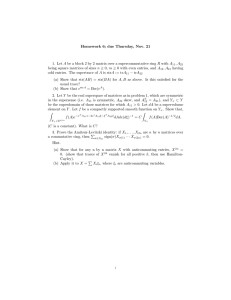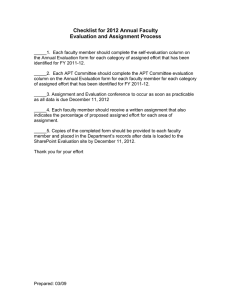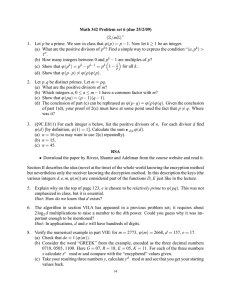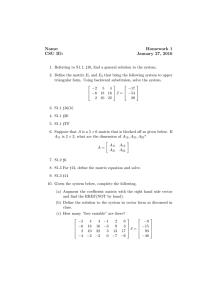Nonlinear Systems
advertisement
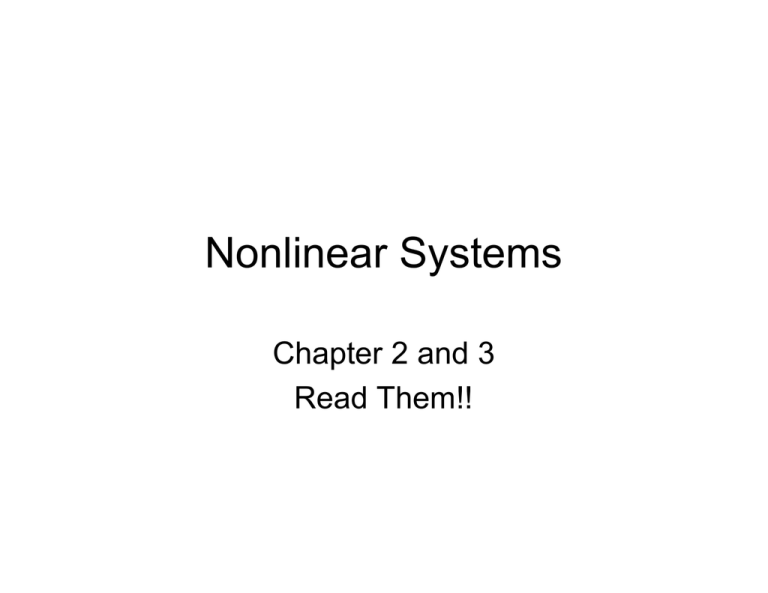
Nonlinear Systems Chapter 2 and 3 Read Them!! Nonlinear Systems x n +1 = f (x n , y n ) y n +1 = g(x n , y n ) • Notes: ! – The functions f and g depend nonlinearly on their arguments ! – Usually these systems cannot reduce to a single equation Nonlinear Systems x n +1 = f (x n , y n ) y n +1 = g(x n , y n ) • Steady States: ! x e = f (x e , y e ) ! y e = g(x e , y e ) • A system of 2 equations and 2 unknowns must be solved ! in order to determine the steady states. • Sometimes it will difficult or impossible to solve for steady ! states analytically. Stability x n +1 = f (x n , y n ) ! • y n +1 = g(x n , y n ) Follow the same steps that were outlined for ! a single nonlinear equation. 1. Let xn = xe + xn yn = ye + yn x n , y n << 1 Stability x n +1 = f (x n , y n ) y n +1 = g(x n , y n ) 2. Substitute into the model equations: ! ! xn = xe + xn yn = ye + yn x e + x n +1 = f (x e + x n , y e + y n ) ! ! y e + y n +1 = g(x e + x n , y e + y n ) ! Stability 3. Expand the right-hand side of each equation in a Taylor series: f (x e + x n , y e + y n ) = f (x e , y e ) + "f "f 2 2 (x e , y e )x n + (x e , y e )y n + L + O x n , y n "x "y ( "g "g 2 2 g(x e + x n , y e + y n ) = g(x e , y e ) + (x e , y e )x n + (x e , y e )y n + L + O x n , y n "x "y ( ) ) Stability 4. Neglect higher order terms: "f "f f (x e + x n , y e + y n ) = f (x e , y e ) + (x e , y e )x n + (x e , y e )y n "x "y "g "g g(x e + x n , y e + y n ) = g(x e , y e ) + (x e , y e )x n + (x e , y e )y n "x "y Stability 5. Simplify "f "f x e + x n +1 = f (x e , y e ) + (x e , y e )x n + (x e , y e )y n "x "y "g "g y e + y n +1 = g(x e , y e ) + (x e , y e )x n + (x e , y e )y n "x "y Let ! "f a11 = (x e , y e ) "x ! a21 = ! "g (x e , y e ) "x ! "f a12 = (x e , y e ) "y a22 = "g (x e , y e ) "y Stability 5. After Simplification x n +1 = a11 x n + a12 y n y n +1 = a21 x n + a22 y n !Therefore, a linear system governs the ! behavior of the perturbations. Stability 6. Reduce to a single higher order equation to find characteristic equation: x n +2 " (a11 + a22 )x n +1 + (a12 a21 " a22 a11 )x n = 0 "2 # (a11 + a22 ) " + (a12 a21 # a22 a11 ) = 0 a11 + a22 ± (a11 + a22 ) 2 # 4(a11a22 # a12 a21 ) " = 1,2 ! 2 Stability 7. Determine the magnitude of the eigenvalues: Let " = a11 + a22 " = a11a22 # a12 a21 # ± # 2 $ 4% "1,2 = 2 ! ! It turns out that "1,2 < 1 if ! ! " < 1+ # < 2 Stability Conclusion • The steady states of the nonlinear system: x n +1 = f (x n , y n ) ! y n +1 = g(x n , y n ) # ± # 2 $ 4% <1 • Are stable if! "1,2 = 2 • The reduces to " < 1+ # < 2 ! Ecological Example Host-Parasitoid Systems Parasitoids • Definition: Insects that have an immature life stage that develops on or within a single insect host, ultimately killing the host. • Major Characteristics – – – – they are specialized in their choice of host they are smaller than host (a few mm long, usually) only the female searches for host different parasitoid species can attack different life stages of host – eggs or larvae are usually laid in, on, or near host – immatures remain on or in host and almost always kill host – adults are free-living, mobile, and may be predaceous Parasitoid Life Cycle This often follows an annual cycle. Parasitoid Facts • Parasitoids are an incredibly diverse and successful type of insect. • There are 50,000 and 15,000 described species of parasitoid wasps and flies respectively, along with around 3,000 in other orders. • Parasitoids make up about 8.5% of all insect species. • They are used biological agents for the control of insect pests. Let’s Try To Model This Behavior! Model Assumptions • Hosts that have been infected in the previous generation will give rise to the next generation parasitoids. • Hosts that have not been infected give rise to the next generation of hosts. • Fraction of hosts that are infected depends on the “searching efficiency” of the parasitoid population or “contact rate” of the two populations. Variables and Parameters • Nt = density of host population in generation t • Pt = density of parasitoid population in generation t • φ(Nt, Pt) = fraction of hosts not infected in generation t, ie the probability of escaping parasitism • λ = host reproductive rate • c = average number of viable eggs laid by a parasitoid in a single host Building the Model Nt+1 = Pt+1 = # of hosts in previous generation # of hosts in previous generation * * probability of hosts not being infected probability of hosts being infected * reproduction rate * # of eggs produced per host General Model Equations N t +1 = "N t # (N t ,Pt ) Pt +1 = cN t [1" # (N t ,Pt )] ! ! Nicholson-Bailey Model 1. Parasitoids search independently and encounters occur randomly 2. The searching efficiency is constant 1. Only the first encounter between the host and the parasitoid is significant. The probability of escaping parasitism is the same as the probability of zero encounters: " (N t ,Pt ) = e #aPt Nicholson-Bailey Model Equations N t +1 = "N t e #aPt Pt +1 = cN t [1" e "aPt ] ! What happens to the hosts when there are no parasitoids? What happens to the parasitoids if there are no hosts? ! Analyzing the Model • Steady States – Let N t +1 = N t = N e Pt +1 = Pt = Pe – Substitute into Model Equations #aPe ! "N e e Ne = "aPe Pe = cN e [1" e ] ! – Solve !N e1 = 0 ! Pe1 = 0 " ln " Ne2 = ac( " #1) ln " Pe 2 = a Analyzing the Model • Steady State Summary – Two sets of steady states • The elimination state: N e1 = 0 Pe1 = 0 • The coexistence state: ! ! " ln " N!e 2 = ac( " #1) ln " Pe 2 = a Exists if and ! only if λ > 1 Analyzing the Model • Stability – Let f (N,P) = "Ne #aP g(N,P) = cN (1" e"aP ) – Compute ! ! "f a11 = (N e ,Pe ) "N a21 = ! ! "g (N e ,Pe ) "N ! ! "f a12 = (N e ,Pe ) "P a22 = "g (N e ,Pe ) "P Analyzing the Model • Stability of the Elimination State f (N,P) = "Ne a11 = ! ! ! #aP "f (0,0) = #e$a(0) = # "N ! "g a21 = (0,0) = c (1# e#a(0) ) = 0 "N ! ! g(N,P) = cN (1" e"aP ) a12 = "f (0,0) = #a$(0)e#a(0) = 0 "P "g a22 = (0,0) = #ac(0)e#a(0) = 0 "P Analyzing the Model • Stability of the Elimination State f (N,P) = "Ne #aP " = a11 + a22 = # ! g(N,P) = cN (1" e"aP ) " = a11a22 # a12 a21 = 0 ! Stability Condition: ! ! ! " < 1+ # < 2 " <1 The elimination state is stable if and only if the compromise state DNE Analyzing the Model • Stability of the Compromise State " ln " Ne2 = ac( " #1) a11 = ! ! ! ! ln " Pe 2 = a "f (N e 2 ,Pe 2 ) = #e$a(Pe 2 ) = 1 "N ! "f #$ ln $ a12 = (N e 2 ,Pe 2 ) = #a$N e 2e#a(Pe 2 ) = "P c( $ #1) % 1( "g #a(Pe 2 ) a21 = (N e 2 ,Pe 2 ) = c (1# e = c'1# * ) & $) "N a22 = "g $ (N e 2 ,Pe 2 ) = #acN e 2e#a(Pe 2 ) = "P $ #1 Analyzing the Model • Stability of the Compromise State ln # " = a11 + a22 = 1+ # $1 $ ln $ " = a11a22 # a12 a21 = $ #1 ! Stability Condition: !Must Show: ! " < 1+ # < 2 ln " " ln " 1+ < 1+ <2 " #1 " #1 Analyzing the Model • Stability of the Compromise State Using graphical arguments and/or a bit of calculus, it is possible to show " ln " >1 " #1 ln " " ln " 1+ < 1+ <2 " #1 " #1 Clearly if λ > 1: This side of the inequality holds ! So for stability we must show: ! " ln " <1 " #1 for all λ > 1 ! The compromise state is always unstable!! Conclusions • The Nicholson-Bailey Model has two steady states. The compromise state is never stable. • This model predicts that when the compromise state exists both populations will undergo growing oscillations. • Interestingly, the green house whitefly and its parasitoid was shown to have this behavior under very specific lab conditions. • The model predicts the exact opposite of the desired effect for a biological control agent. Numerical Simulation Experiments with the greenhouse whitefly and its parasitoid, provides the closest correspondence (for nearly 20 generations) with the Nicholson-Bailey model. λ = 2, c = 1, a = 0.068, initial host 24, initial parasite 12. Long Time Simulation • Eventually the parasitoid population crashes and the host population explodes. Modifying the N-B Model • Surely, natural systems are more stable than this. • Let try modifying the assumptions that underlie the host population and investigate whether these modifications have a stabilizing effect. Modifying the N-B Model • Assume that in the absence of parasitoids, the host population grows to a limited density determined by the environmental carrying capacity. • How would the model equations change? N t +1 = "( N t ) N t e#aPt Pt +1 = cN t [1" e ! "aPt ] Modifying the N-B Model • Let’s choose "( N t ) = e ! ! ! N t +1 = N t e $ Nt ' r &1# ) % K ( ) # Nt +r %1" * $ K Pt +1 = cN t [1" e , & ("aPt . ' - "aPt ] Numerical Analysis Nt ) " aPt ] K Pt +1 = N t (1 " exp("aPt )) N t +1 = N t exp[r(1 " ! ! What’s going on here? Numerical Analysis Nt ) " aPt ] K Pt +1 = N t (1 " exp("aPt )) N t +1 = N t exp[r(1 " ! ! For small r, the nontrivial steady state is stable. The iterates move along a “spiral galaxy”. Numerical Simulation • Solutions oscillate towards a stable coexistence equilibrium. Numerical Analysis Nt ) " aPt ] K Pt +1 = N t (1 " exp("aPt )) N t +1 = N t exp[r(1 " ! ! What’s going on here? Numerical Analysis Nt ) " aPt ] K Pt +1 = N t (1 " exp("aPt )) N t +1 = N t exp[r(1 " ! ! As r increases, the nontrivial steady state becomes unstable. The iterates move along a stable limit cycle. Numerical Analysis Nt ) " aPt ] K Pt +1 = N t (1 " exp("aPt )) N t +1 = N t exp[r(1 " ! ! What’s going on here? Numerical Analysis Nt ) " aPt ] K Pt +1 = N t (1 " exp("aPt )) N t +1 = N t exp[r(1 " ! ! As r increases further, the non-trivial steady state remains unstable. The iterates move along a 5-point cycle. Numerical Analysis Nt ) " aPt ] K Pt +1 = N t (1 " exp("aPt )) N t +1 = N t exp[r(1 " ! ! What’s going on here? Numerical Analysis Nt ) " aPt ] K Pt +1 = N t (1 " exp("aPt )) N t +1 = N t exp[r(1 " ! ! Still larger values of r yield either chaos or cycles of extremely high period. This chaotic behavior begins to fill a sharply bounded area of phase space. Other Potentially Stabilizing Modifications • Heterogeneity of the environment – Part of the population may be less exposed and therefore less vulnerable to attack. – How could we model this situation? – You’ll get the chance to explore this in Homework 3.


